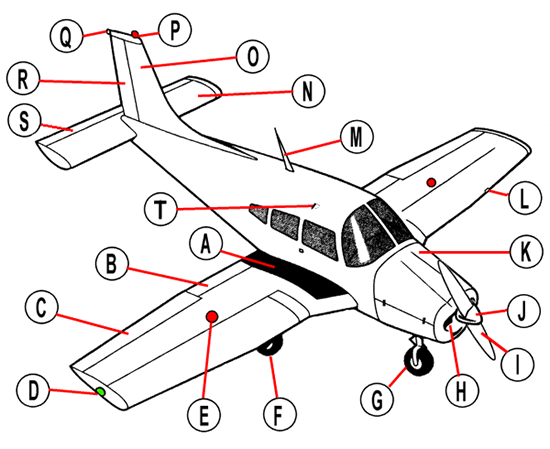Piper PA28 Cherokee Warrior
Parts Check
CLICK ON LETTERS FOR DESCRIPTION

A Wing-walk: Rough, non-slip surface on strengthened part of wing for walking.
B Flap: Small amounts are used to increase lift for landing and take-off, while larger angles increase drag for landing.
C Aileron: There is one on each wing, and one moves up and the other down to roll the plane for turns.
D Wing-tip light: Navigation lights so other pilots can work out which way you are heading at night. Green on the right (starboard) wing and red on the left (Port) wing.
E Fuel-tank cap: It’s important to ensure it is firmly on after you check the level each flight.
F Main-wheel: The undercarriage on this plane is a tricycle type – it has 2 main-wheels and one nose-wheel.
G Nose-wheel: This may be steered by the rudder pedals, or free to turn like a supermarket trolley, when brakes on each main-wheel might be used for steering.
H Air-intake: This is vital for cooling the engine and supplying air for burning the fuel, and must be checked clear of debris before starting up.
I Propeller: Keep clear at all times to save serious injury. Even when engines are off, a propeller can suddenly turn if there is an ignition fault.
J Spinner: This protects the hub of the propeller and makes it more streamline.
K Cowling: This fits closely to the engine so air can flow very near to the hot parts to cool them. It also streamlines the engine to reduce drag.
L Stall-warner: When the plane is flying too slowly, and is in danger of stalling, the small vane in this device flips up and sets off a warning light and horn in the cockpit.
M Radio aerial: There are often several radio sets on board; two transmitter/receivers and a number of radio navigational aids. Some small planes might just use a hand-held transmitter/receiver.
N Tailplane: This helps the aircraft fly level. On this plane it tilts up and down and is called a stabiliser, but on other sorts of planes it is fixed and an elevator does that job.
O Tail-fin: This keeps the aircraft heading straight, though in a strong side-wind, it can make it trickier.
P Flashing beacon (red): This warns other planes if they are close enough. Very bright flashing lights might also be fitted on the wing tips. A plane on the ground may start its beacon flashing just before starting its engines.
Q Tail-light: This white light is visible from behind to warn a following aircraft of the plane in front.
R Rudder: This allows the plane to steer left or right. It may be used to work with the ailerons in turns.
S Elevator: This makes the plane pitch more nose-up or nose-down to adjust the attitude. On this plane it is used to help adjust the stabiliser (moving tailplane) and is called a trim-tab (anti-servo tab actually).
T Door-lock lever: This can be opened from inside or outside, but is designed to seal the door tightly and prevent it opening accidentally.
Now try a quiz and see how much you have learnt?
